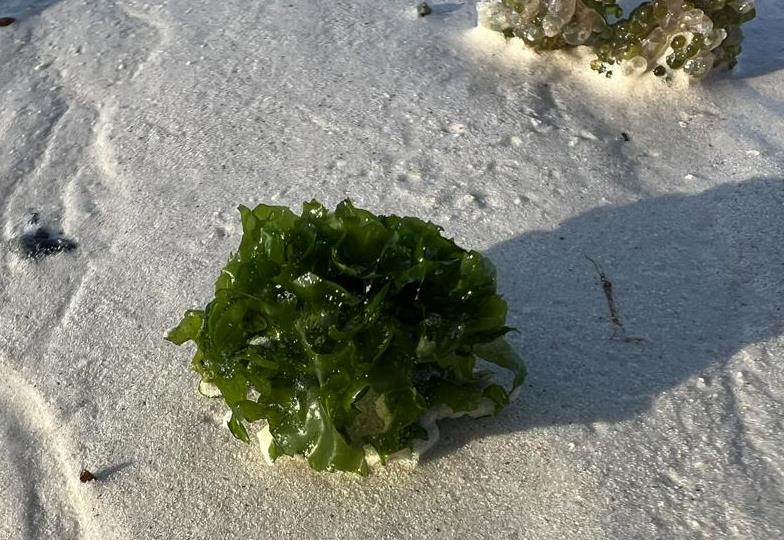Sea lettuce (Ulva lactuca) is common on most shorelines worldwide. This article focuses on the island of Zanzibar in Tanzania. There, sea lettuce is used as an export article and supplementary food for humans. In addition to being collected in the wild, (Compton, 2024) reported about trials of cultivating and farming U. lactuca for higher yields in this country.

Description and distribution
According to (Braune & Guiry, 2011), the color of U. lactuca is light green to deep green. When dried by the sun, the colour of the seaweed can range from white to black. Its leaf-like flattened thallus is rounded, relatively soft, and smooth. It is undulated at the edges with smooth margins. These ruffle-edged leaves resemble lettuce leaves, but that can grow to 50 centimetres in length.

The leaves of most forms of U. lactuca are only one or two cells thick, so they often display tattered edges and perforated holes. Sea lettuce is a widespread green algae species in intertidal pools and estuaries. It can tolerate a wide range of salinities that may be caused by rain diluting the sea or heat, causing evaporation and an increase in salinity. The spores are formed along the fronds’ edges and released on the rising tide when cool water enters pools. The waves disperse the spores to colonize new areas.

Harvesting sea lettuce
Sea lettuce is found in the upper intertidal zones of the lagoons around Zanzibar Island. Young Ulva seedlings clinch to solid substrates, but mature ones are also known to float freely. Harvesting of the algae is often impeded by the sea lettuce’s intermingling with other red- and brown algae species.

Seaweeds must be harvested carefully to ensure that they continue to grow and flourish. A sharp knife or scissors should be used to cut off only the upper leaf area. This will allow them to regrow and make the cleaning process of these leaves much more manageable. The gritty holdfast, the seaweed’s equivalent of a root, should stay on the substrate.
Sea lettuce trade

The ‘Daily News’ of Zanzibar (Said, 2023) reported that the newly established Zanzibar Seaweed Company (ZASCO) now buys Ulva seaweed from locals. This seaweed was previously regarded as waste and an environmental nuisance.

According to the Daily News, ZASCO’s Director General reported spending over 960 m TZS (350,000 USD) in five months, purchasing 1,200 tonnes at 800 TZS (0.3 USD)/kg TZS = Tanzanian Shilling.
ZASCO buys Ulva seaweed from local harvesters and collectors at a dedicated marketplace and sells it to international customers as a raw material for biofilter, fish bait, ingredient in animal feed, or consumed as human food.

How to prepare salad from sea lettuce
When using sea lettuce as food for humans, a classic recipe for such a salad is the following:
- For seaweed salad, the sea lettuce must first be thoroughly cleaned from sand and other debris. The seaweed should then be added to a large bowl or bucket of water. After the first wash, the container should be emptied and filled again with clean water. The seaweed should then be washed again until the water is completely clear.
- In the next step, the seaweed should be placed in a pot and covered with boiling water. It should be blanched for 1-2 minutes to soften the seaweed’s structure, which makes a noticeable difference in chewiness.
- After cleaning, excess moisture should be strained and squeezed from the plant material to remove excessive liquid.
- If using dried seaweed, it should be covered with hot water and rehydrated for 10 minutes.
- A dressing with whatever ingredients are available should be prepared. An excellent dressing mixture would be a mixture of soy sauce, rice vinegar, lime juice, sugar, ginger, garlic, sesame oil, and red pepper flakes.
- The seaweed should be added to the bowl with dressing and tossed well to coat.
- The salad should be served immediately or refrigerated for 30 minutes to marinate the flavors. When ready to serve, it should be garnished with toasted and black sesame seeds.

Other ways to use sea lettuce as food for humans
Generally, sea lettuce can be eaten raw, dried, or added to soups and stews. Eating fresh and raw is the most pleasing. Ulva is easy to spot along the coast and tastes delicious from the water. Its taste is surprisingly less fishy than that of other seaweeds. Furthermore, it contains lots of macro- and micro-nutrients.
Another proposal would be to dry the sea lettuce until it is crispy. Whether to powder the crisps into sea lettuce flakes or powder depends on their intended further use. One such use would be as an ingredient for various soups, for which coarse flakes are preferable. Sea lettuce powder, on the other hand, can even be used as a replacement for wheat or lentil flour in various fried or baked Asian or African dishes.

Nutritional value of sea lettuce
Debbarma et al. (2016) reported nutritional profiling of Ulva lactuca and other seaweeds. Their results were as follows:


Presented lists only show the primary nutrients. All other macro- and micronutrients, essential fatty acids, and fat-soluble vitamins are present in sea lettuce in minor quantities.
Lessons learned about sea lettuce:
- On the island of Zanzibar, sea lettuce can be found in all intertidal coastal zones.
- Ulva lactuca is now bought from harvesters and collectors by a Tanzanian state-owned company for international trading.
- Making a seaweed salad is one of the best ways to relish sea lettuce.
- Another way to enjoy them is to eat them raw if the water is not polluted.
Further readings about Seaweeds on this website:
Edible red seaweed on Zanzibar beaches
Purple Laver – cherished food in many cultures
.





